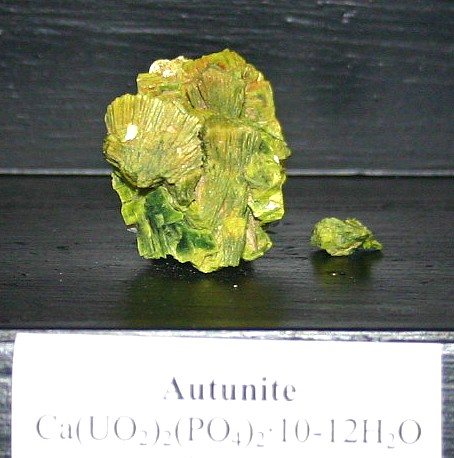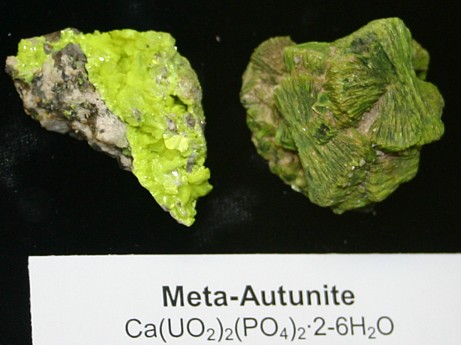|
.
Autunite Mineral Facts:
Chemical Formula: Ca(UO2)2(PO4)2-8H2O
The mineral is a hydrated phosphate of calcium and uranium.
Colors:
Bright sulfur Yellow to yellow green, lemmon yellows, etc.
It's streak is yellow.
The color is
typical for uranium minerals.
Hardness:
2 to 2.5
Density:
3.05 to 3.19
Cleavage:
One perfect cleavage parallel to the crystal base. Thin brittle lamina
result from cleavage.
Crystallography:
Orthorhombic
Crystals of Autunite occur in thin tabular crystals with a distinctly
tetragonal habit, and in foliated and micaceous masses. The lamina are
brittle and not flexible, and in this respect they differ from the
lamina
of mica.
Luster:.
Subadamantine, but on
cleavage faces pearly.
It is transparent to translucent..
Optics:
(Refractive Index): a= 1.6720; b= 1.6779; y = 1.6810
|
 |
|
Composition,
Structure and Associated Minerals:
The uranites are a group of phosphates, arsenates and vanadates
containing uranium in the form of the radical uranyl (UO2) which is
bivalent. The members of the group are either tetragonal, or orthorhombic
with a tetragonal habit. They all contain eight molecules of
water of crystallization. Only three members of the group are potentially
important economically. These are the hydrated copper
and calcium uranyl phosphates, torbernite and autunite and the potassium
uranyl vanadate, carnotite. The uranites are of interest because of their
content of the element uranium.
Identification and Diagnostics
The mineral reacts like torbernite before the blowpipe and with acids,
except that it shows none of the tests for copper. It is recognized by its
color, streak and specific gravity. Heated in closed tube, yields water.
Soluble in nitric acid. Heated alone, fuses to a blackish mass, and colors
the flame green. Gives no reaction for copper, otherwise its behavior with
reagents resembles that of torbernite.
Occurrence,
Localities and Origins:
Autunite occurs in
thin tabular crystals with a distinctly tetragonal habit, and in foliated
and micaceous masses. The percentage composition corresponding to the above
formula is 6.1 per cent CaO, 62.7 per cent UO2, 15.5 per cent P2O5 and 15.7
per cent H2O. Its crystals are orthorhombic (bipyramidal class), thus
possessing interfacial angles that closely approach those of torbernite.
Autunite occurs in pegmatite
veins and on the walls of cracks in rocks near igneous intrusions,
especially in association with
other uranium compounds, of which it is a decomposition product. Localities.
It has been found at Johanngeorgenstadt, Germany; Cornwall, England; at
Middletown and Branchville, Conn., in the mica mines of Mitchell County,
North Carolina, and coating cracks in gneiss near Baltimore, Md.
Return to the
Mineral Collectors Information Page
|



